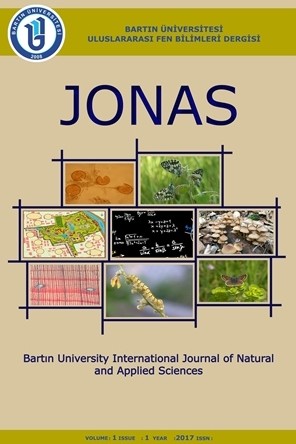BAZI ARPA GENOTİPLERİNDE KURŞUN TOLERANSININ KLOROFİL A FLORESANSI İLE DEĞERLENDİRİLMESİ
Arpa, klorofil floresansı, kurşun, toksisite
EVALUATION OF LEAD TOLERANCE IN SOME BARLEY GENOTYPES BY MEANS OF CHLOROPHYLL A FLUORESCENCE
Barley, chlorophyll fluorescence, lead, toxicity,
___
- 1. Adamia G., Khatisashvili G., Varazashvili T., Pruidze M., Ananniasshvili T., Gvakharia V., Adamia T. & Gordeziani M. (2003). Determination of the type and rate of soil contamination with heavy metals and organic toxicants on the territories of military proving grounds in Georgia. Bull Georg Acad Sci, 167, 155-158.
- 2. An Y. (2006). Assessment of comparative of lead and copper using plant assay. Chemosphere, 62, 1359-1365.
- 3. Angelone M. & Bini C. (1992). Biogeochemistry of trace metals, Lewis Publishers, Boca Raton, London.
- 4. Bilal S., Khan A.L., Kim Y.H., Imran M., Khan M.J., Al-Harrasi A., Kim T.H. & Lee I.J. (2018). Mechanisms of Cr (VI) resistance by endophytic Sphingomonas sp. LK11 and its Cr (VI) phytotoxic mitigating effects in soybean (Glycine max L.). Ecotoxicol Environ Safety, 164, 648–658.
- 5. Björkman O. & Demmig B. (1987). Photon yield of O2 evolution and chlorophyll fluorescence characteristics at 77 K among vascular plants of diverse origin. Planta, 170, 489-504.
- 6. Bussotti F., Strasser R.J. & Schaub M. (2007). Photosynthetic behaviour of woody species under high ozone exposure probed with the JIP-test: a review. Environ Pollut 147, 430–437.
- 7. Cohen S.M. (2001). Lead poisoining: a summary of treatment and prevention. Pediatr Nutr 27, 125-130.
- 8. Elumalai R.P., Nagpal P. & Reed J.W. (2002). A mutation in the Arabidopsis KT2/KUP2 potassium transporter gene affects shoot cell expansion. Plant Cell, 14, 119-1313.
- 9. Ernst W.H.O., Nielsseni H.G.M. & Ten Bookum W.M. (2000). Combination toxicology of metal-enriched soils: physiological responses of a Zn- and Cd-resistant ecotypes of Silene vulgaris on polymetallic soils. Environ Exp Bot, 43, 55-71.
- 10. Georgieva K. & Lichtenthaler H.K. (1999). Photosynthetic activity and acclimation ability of pea plants to low and high temperature treatment as studied by means of chlorophyll fluorescence. J Plant Physiol 155, 416-423.
- 11. Gupta D.K., Nicoloso F.T., Schetinger M.R.C., Rossato L.V., Pereira L.B., Castro G.Y., Srivastava S. & Tripathi R.D. (2009). Antioxidant defense mechanism in hydroponically grown Zea mays seedlings under moderate lead stress. J Hazard Mater, 172, 479-484.
- 12. Kalaji H.M., Govindjee Bosa K., Koscielniak J. & Zuk-Golaszewska K. (2011). Effects of salt stress on photosystem II efficiency and CO2 assimilation of two Syrian barley landraces. Env Exp Bot, 73, 64-72.
- 13. Kovalchuk I., Titov V., Hohn B. & Kovalchuk O. (2005). Transcriptome profiling reveals similarities and differences in plant responses to cadmium and lead. Mutat Res. Fund Mol Med, 570, 149-161.
- 14. Kupper H., Kupper F. & Spiller M. (1996). Environmental relevance of heavy metal substituted chlorophylls using the example of water plants. J Exp Bot, 47, 259-266.
- 15. Malkowski E., Kita A., Galas W., Karcz W. & Kuperberg J.M. (2002). Lead distribution in corn seedlings (Zea mays L.) and its effect on growth and the concentrations of potassium and calcium. Plant Growth Regul 37, 69-76.
- 16. Maxwell K. & Johnson G.N. (2000). Chlorophyll fluorescence-A practical guide. J Exp Bot 51, 659-668.
- 17. Oukarroum A., Bussotti F., Goltsev V. & Kalaji H.M. (2015). Correlation between reactive oxygen species production and photochemistry of photosystems I and II in Lemna gibba L. plants under salt stress. Env Exp Bot, 109, 80-88.
- 18. Pereira W.E., de Siqueira D.L., Martinez C.A. & Puiatt M. (2000). Gas exchange and chlorophyll fluorescence in four citrus rootstocks under aluminum stress. J Plant Physiol, 157, 513–520.
- 19. Qufei L. & Fashui H. (2009). Effects of Pb2+ on the structure and function of photosystem II of Spirodela polyrrhiza. Biol Trace Elem Res, 129, 251-260.
- 20. Rusin V.Y. (1988). Lead and its compounds, Khimiya, Leningrad.
- 21. Schüzendübel A., Schwanz P., Teichmann T., Gross K., Langenfeld-Heyser R., Godbold D.L. & Polle A. (2001). Cadmium-induced changes in antioxidative systems, hydrogen peroxide content, and differentiation in Scots pine roots. Plant Physiol, 127, 887-898.
- 22. Shadid M., Dumat C., Silvestre J. & Pinelli E. (2012). Effect of fulvic acid on lead-induced oxidative stress to metal sensitive Vicia faba L. plant. Biol Fertil Soils, 48, 689-697.
- 23. Singh R., Tripathi R.D., Dwivedi S., Kumar A., Trivedi P.K. & Chakrabarty D. (2010). Lead bioaccumulation potential of on aquatic macrophyte Najas indica are related to antioxidant system. Bioresour Technol, 101, 3025-3032.
- 24. Sobotik M., Ivanov V.B., Obroucheva N.V., Seregin I.V., Martin M.L., Antipova O.V. & Bergmann H. (1998). Barrier role in root systems in lead-exposed plants. J App Bot, 72, 144-147.
- 25. Şahin, S. (2001). Türkiye’de Mısır Ekim Alanlarının Dağılışı ve Mısır Üretimi. G.Ü. Gazi Eğitim Fakültesi Dergisi 1, 73-90.
- 26. Verma, S. & Dubey, R.S. (2003). Lead toxicity induces lipid peroxidation and alters the activities of antioxidant enzymes in growing rice plants. Plant Sci, 164, 645-655.
- 27. Wang C.R., Wang X.R., Tian Y., Yu H.X., Gu X.Y., Du W.C. & Zhou H. (2008). Oxidative stress, defence response, and early biomarkers for lead-contaminated soil in Vicia faba seedlings. Environ Toxicol Chem, 27, 970-977.
- 28. Xiong Z.T., Zhao F. & Li M.J. (2006). Lead toxicity in Brassica pekinensis Rupr. effect on nitrate assmilation and growth. Environ Toxicol, 21, 147-153.
- Yayın Aralığı: Yılda 2 Sayı
- Başlangıç: 2017
- Yayıncı: Bartın Üniversitesi
SERBEST ORMANCILIK BÜROLARININ HUKUKSAL SORUNLARI VE ÇÖZÜM ÖNERİLERİ
CONTRIBUTIONS TO THE SOLUTION OF PHYLOGENETIC PROBLEM IN FABALES
Deniz AYGÖREN ULUER, Rahma ALSHAMRANI
AGAR WELL DİFÜZYON YÖNTEMİNDE STANDARDİZASYON ÇALIŞMASI
Mehmet AYTAR, Erman ORYAŞIN, Gamze BAŞBÜLBÜL, Bülent BOZDOĞAN
BAZI ARPA GENOTİPLERİNDE KURŞUN TOLERANSININ KLOROFİL A FLORESANSI İLE DEĞERLENDİRİLMESİ
Emprou EMINOUGLOU, Mustafa ÖZKAN, Belgin ELİPEK
Süheyla ÜNAL, Mustafa KARAKAPLAN, Erdinç ÖZ, İsmet YILMAZ, Serdar ALTIN, Ali BAYRİ
HAVAN MÜHİMMATI TAPALARINDA EMNİYET MEKANİZMALARININ İNCELENMESİ
Serhad YILDIZ, Zühtü Onur PEHLİVANLI
EFFECT OF BIOMASS HYDROLYSATE ON SOIL AND PLANT PHENOLIC CONTENTS
KENTSEL DÖNÜŞÜM PROJELERİNE EKOLOJİK BOYUT KAZANDIRILMASINA İLİŞKİN GÖRÜŞLER
